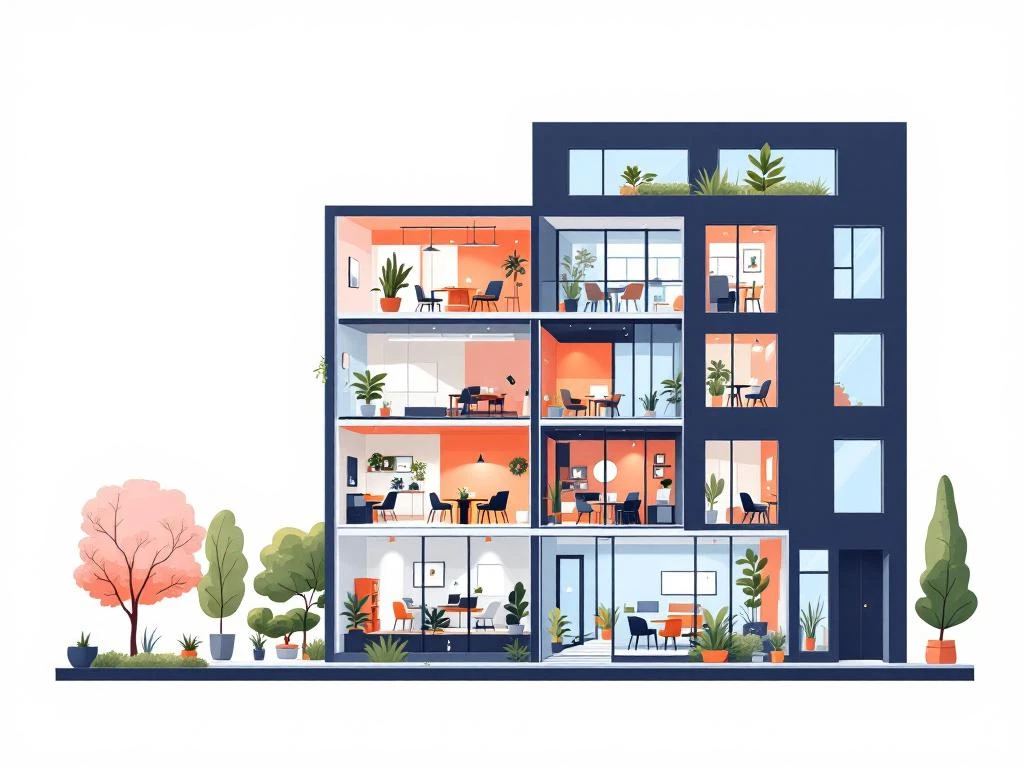A good office space meets several important conditions that directly affect your team's productivity and enjoyment of work. The basics include sufficient space per employee, good ventilation, natural light, ergonomic workstations and a reliable Internet connection. In addition, location, accessibility and the presence of modern facilities play a major role. Flexibility in rental terms and the ability to grow with your company are also indispensable nowadays.
What are the main requirements for a good office space?
The fundamental requirements for an office space begin with sufficient workspace for every employee. This means not only a desk and chair, but also space for movement and access to common facilities. Good ventilation provides fresh air and prevents concentration problems, while natural light significantly improves employee well-being.
Ergonomic workstations today are no longer a luxury but a necessity. Adjustable desks, good chairs and correctly positioned monitors prevent physical complaints and increase productivity. A reliable internet connection with sufficient bandwidth for all employees is, of course, the backbone of any modern office.
Basic facilities such as clean restrooms, a kitchen or pantry, and adequate storage space complete the picture. These practical aspects directly impact how comfortably and efficiently your team can work. For more information on all aspects of finding the right workspace, check out our complete guide to renting office space. Also, don't forget to consider good lighting for the dark months, climate control for both summer and winter, and enough electrical outlets for all equipment.
What location factors are important when choosing an office?
The accessibility of your office largely determines how attractive you are as an employer. A location that is easily accessible by both public transportation and car makes it easier for employees to arrive on time. Consider proximity to train stations, bus stops or subway stations, as well as good connections to highways for employees coming by car.
Parking options are especially important if you regularly receive visitors or if many employees come by car. Check whether there are enough parking spaces, what the costs are, and whether there are alternatives such as Park+Ride nearby. The presence of amenities such as restaurants, stores and banks in the area make daily life much more pleasant for your employees.
Neighborhood safety should not be underestimated. Employees need to feel safe, especially if they are working late at night. A presentable address can be important to your business image, especially if you regularly receive clients. For example, if you have a office space for rent Amsterdam considering, look for neighborhoods that fit your business profile and are accessible to your target audience.
How many square feet of office space do you need per person?
The standard guideline for office space is between 8 and 12 square meters per employee, depending on the type of workspace. For an open office space, you can count on about 8-10 sq. ft. per person, including aisles and general space. For private offices, you quickly need 12-15 sq. ft. because of the extra walls and doors.
Remember that you also need space for meeting rooms, a kitchen, restrooms and possibly a reception area. A good rule of thumb is to set aside about 25-30% of extra space on top of the workstations for these shared amenities. This ensures that your office does not feel too crowded and there is plenty of room for movement and interaction.
You can find the right balance between efficient use of space and working comfort by listening carefully to your team. Some jobs require more concentration and thus more distance from colleagues, while creative teams benefit from a more open setup. Flexible workstations can help use space more efficiently, especially if not everyone is in the office at the same time.
What are must-have facilities in a modern office?
A high-quality internet connection is at the top of the list of indispensable facilities. Think fiber optics with enough bandwidth for video meetings, cloud applications and sharing large files. Climate control is just as important - a pleasant year-round temperature significantly increases productivity.
Kitchen and lunch facilities make the difference between employees staying in the office all day or leaving for lunch. A good kitchen with refrigerator, microwave and dishwasher, plus a cozy lunch area, promotes team atmosphere. Clean and modern washroom facilities are a given, but also consider enough toilets for the number of employees.
| Facility | Why Important | Minimum requirements |
|---|---|---|
| Internet | Basis for all digital work | 100 Mbps up/down per 10 employees |
| Meeting rooms | Professional meetings and brainstorms | 1 room per 15-20 employees |
| Kitchen | Comfort and social interaction | Refrigerator, microwave, coffee maker |
| Storage | Orderly workplace | Locker cabinet or drawer per employee |
Meeting rooms with good presentation capabilities such as beamers, whiteboards and videoconferencing equipment are indispensable for professional meetings. Adequate storage space, both personal and general, keeps the workplace neat and organized.
How important is natural light in an office space?
Natural light has a huge impact on employee productivity, mood and health. Studies show that people who work in daylight sleep better, have fewer headaches and feel more energetic. It also helps regulate your biological clock, which is especially important in the winter.
To make the most of daylight, place workstations as close to windows as possible. Use light colors for walls and furniture to reflect light, and avoid tall cabinets or partitions that block light. Shades are necessary to prevent glare on screens, but choose solutions that filter light rather than completely block it.
If natural light is limited, invest in good artificial lighting that mimics daylight. LED lights with a color temperature between 4000K and 5000K are the closest to natural light. Provide a combination of general lighting and task lighting so employees can adjust their workspace to suit their needs.
What flexibility should an office space offer?
Flexible leases are more important today than ever. Companies are growing, shrinking or changing strategies, and your office space must be able to move with them. Look for options with shorter notice periods or the ability to expand or downsize in the interim without high penalties.
Office layout should be adaptable to changing needs. Moveable walls, modular furniture and multipurpose spaces give you the freedom to rearrange the space as your team grows or your workflow changes. Also consider different types of workspaces: quiet rooms for concentrated work, collaborative spaces for team projects, and informal meeting areas for creative sessions.
Scalability is another important aspect of flexibility. Can you easily rent additional workstations in the same building? Is there room to accommodate temporary employees or interns? This flexibility prevents you from having to move within a year because you are outgrowing your space.
What is the difference between a traditional office and a flexible workspace?
The biggest difference is in the form of contract and the level of service. With a traditional office, you usually sign for at least 3-5 years, while flexible workspaces offer monthly contracts or even day passes. This gives startups and growing companies the freedom to scale up quickly without big financial risks.
A traditional office gives you complete control over the layout and appearance, but it also requires a hefty investment in furniture, IT infrastructure and facilities. Flexible workspaces offer turnkey workspaces with all amenities included. You literally step inside and can get right to work.
Sharing facilities is another key difference. In a traditional office, you have everything to yourself but also pay full cost. In flexible workspaces, you share meeting rooms, kitchens and other facilities with other companies, which is cost-effective but offers less privacy. For many modern businesses, the benefits of flexibility and lower start-up costs outweigh the lack of exclusivity.
How do you check if an office space meets all legal requirements?
Start by checking fire safety: are there enough emergency exits, functioning smoke detectors and fire extinguishers? The landlord must be able to show a valid fire safety certificate. Also check that the escape routes are clearly marked and free of obstacles.
Ventilation requirements are strictly regulated by the Occupational Health and Safety Act. An office must supply sufficient fresh air and exhaust polluted air. Ask about the ventilation system and whether it has been recently checked. Accessibility for the disabled is required by law: consider barrier-free entrances, adapted toilets and elevators in multi-story buildings.
Make a checklist of important documents you want to see:
- Use permit from the municipality
- Energy label of the building
- Latest plant inspection reports
- Asbestos declaration (for buildings constructed before 1994)
- Certificates for elevators and air conditioning systems
If you doubt the completeness of the documentation, call in an expert for a second opinion. It is better to have certainty in advance than to have surprises afterwards.
Why is a good working atmosphere as important as physical space?
An inspiring environment encourages creativity and motivation much more than just functional workstations. The furnishings, colors, art on the wall and even the smell of fresh coffee all contribute to how employees feel in the office. A good working atmosphere is created when the physical space invites collaboration and interaction.
Common areas play an important role in creating a positive working atmosphere. A cozy coffee corner, a lounge for informal meetings or a rooftop terrace for lunch promote spontaneous meetings between colleagues. These informal interactions often lead to new ideas and stronger team bonds.
The opportunity to network, especially in shared office spaces, adds an extra dimension to your work experience. You come into contact with professionals from other industries, which can lead to interesting collaborations or new insights. An office environment that facilitates this directly contributes to employee satisfaction and reduces turnover. Employees who feel comfortable in their workplace are more productive, creative and loyal to the company.
Conclusion: this is how to find the perfect office space for your business
Finding the perfect office space requires careful consideration of all the factors discussed. Start by identifying your must-haves: how many workspaces do you need, what facilities are essential, and what is your budget? Differentiate between nice-to-haves and deal-breakers to stay focused during your search.
Follow this practical step-by-step plan for evaluating options:
- Make a list of all requirements and wishes
- Determine your search area based on accessibility
- Visit at least 5 different locations
- Take key employees for a second opinion
- Ask for references from current tenants
- Test internet speed and check all facilities
- Negotiate contract terms and flexibility
At Co-Office, we understand that every business has unique needs when it comes to workspace. Our flexible workspaces meet all the modern requirements we've discussed in this article, from excellent locations to state-of-the-art facilities. Whether you're looking for an inspiring place for your startup or a professional base for your growing team, we're happy to help you find the perfect match. Visit contact with us to discuss the possibilities and find out how we can transform your work experience.

